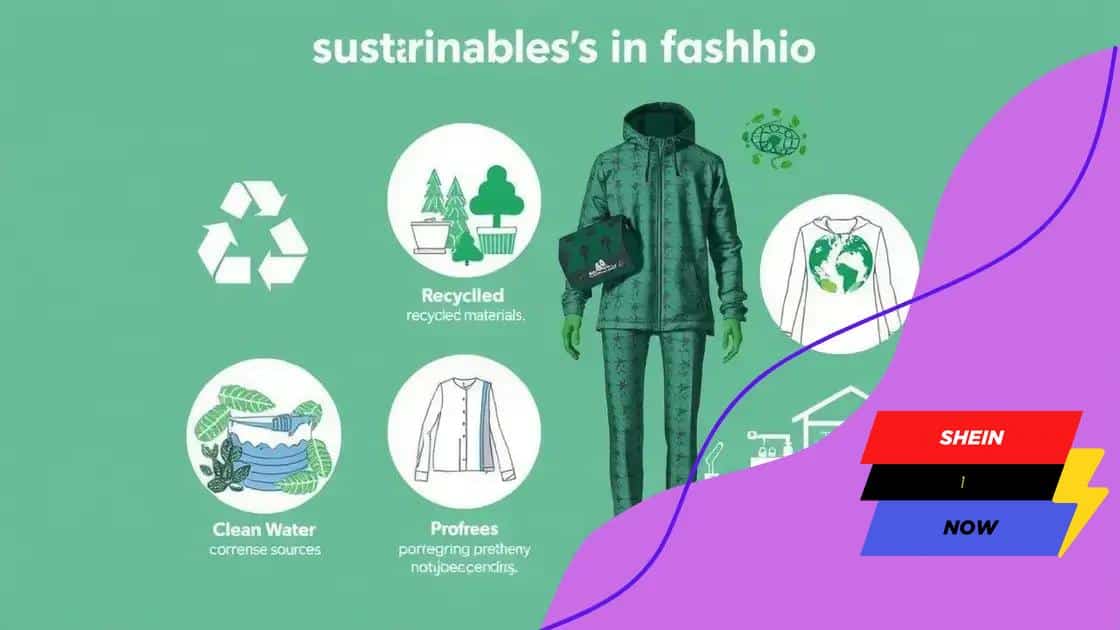Shein’s investment in sustainable production methods

Shein’s investment in sustainable production methods focuses on using eco-friendly materials, enhancing transparency, and adopting innovative practices to meet consumer demand for sustainability while navigating challenges inherent in the fast fashion industry.
Shein’s investment in sustainable production methods is capturing attention as the fashion world shifts towards more eco-friendly practices. Have you ever wondered how a fast fashion giant can reconcile profit with planet? In this article, we delve into these innovative efforts.
Understanding Shein’s approach to sustainability
Understanding Shein’s approach to sustainability reveals how fast fashion can merge with eco-friendly practices. This fashion giant is actively working to reduce its environmental impact while providing trendy clothing at affordable prices.
Eco-Friendly Materials
Shein is increasingly sourcing sustainable materials, such as organic cotton and recycled polyester. These materials not only help in reducing waste but also lower the carbon footprint of production processes.
- Use of organic and recycled fabrics
- Reduction of harmful chemical use
- Encouragement of circular fashion
Moreover, they aim to innovate their supply chain, looking for ways to be more efficient. This not only benefits the planet but can also improve their business model. Consumer awareness around sustainability is rising, and brands like Shein need to adapt.
Transparent Operations
Another key aspect of Shein’s sustainability strategy is their commitment to transparency. By sharing their supply chain practices, they allow consumers to make informed choices. This openness builds trust and encourages a loyal customer base.
Investing in technologies that monitor their production processes can help to ensure ethical labor practices. The more they share, the more consumers become aware of the brand’s genuine efforts.
Community and Recycling Initiatives
Shein has launched various initiatives to involve the community in its sustainability journey. For instance, their recycling programs encourage customers to send back old clothes in exchange for discounts. This cycle of reuse is vital for reducing waste in landfills.
- Engagement in local community projects
- Hosting clothing drives and recycling events
- Partnerships with sustainable organizations
Through these efforts, Shein promotes not just consumption but responsibility among its customers. Overall, understanding Shein’s approach to sustainability gives insight into the evolving nature of the fashion industry.
Innovative production technologies employed by Shein
Innovative production technologies employed by Shein are reshaping the company’s approach to fast fashion. By leveraging cutting-edge techniques, Shein aims to meet consumer demands while minimizing their environmental impact.
Automation and Efficiency
One of the core technologies Shein uses is automation in manufacturing. This technology allows for faster production times and reduces human error. Automated systems can track inventory levels and optimize workflows, making the production process smoother.
- Enhanced production speed
- Reduced labor costs
- Improved quality control
These efficiencies not only help Shein produce garments quickly but also allow them to respond to trending styles almost in real-time.
Data-Driven Design
Another significant innovation is the use of data analytics in design. Shein analyzes vast amounts of consumer data to understand preferences and buying behaviors. This approach ensures that their collections align with what shoppers desire.
By predicting trends based on real-time data, Shein can stock items that are likely to sell well, reducing waste and increasing profitability.
Sustainable Manufacturing Processes
In addition to automation and data analytics, Shein is exploring sustainable manufacturing processes. They invest in technologies that reduce water usage and energy consumption. This commitment not only enhances sustainability but also appeals to environmentally conscious consumers.
- Utilization of eco-friendly dyes
- Water-efficient machinery
- Energy-saving production methods
Incorporating these technologies helps Shein pave the way toward a more sustainable fashion future while catering to a growing market demand for eco-friendly options.
Ultimately, the innovative production technologies employed by Shein reflect a commitment to efficiency, responsivity, and sustainability in the fashion industry.
Impact of sustainable practices on the environment

The impact of sustainable practices on the environment is profound and far-reaching. As companies like Shein adopt these practices, they contribute to a healthier planet and a brighter future for generations to come.
Reduction of Waste
One major benefit of sustainable practices is the significant reduction of waste. By utilizing recycled materials and creating clothing designed for circularity, brands can minimize their landfill overflow.
- Encouragement of recycling programs
- Promotion of upcycling old clothes
- Decrease in single-use packaging
This shift not only lowers the volume of trash produced but also helps in conserving resources, which is essential for sustainable development.
Conservation of Resources
In addition to reducing waste, sustainable practices lead to the conservation of vital resources. For example, the use of eco-friendly fabrics often requires less water and energy to produce. Sustainability in fashion helps ensure that we do not deplete natural resources at alarming rates.
Brands are also investing in technologies that make production cleaner and more eco-friendly. This helps create a balance between production demands and resource availability.
Improvement of Air and Water Quality
Implementing sustainable practices can lead to better air and water quality. Traditional textile production often involves harmful chemicals that can pollute local water supplies and air. By switching to non-toxic dyes and materials, brands can reduce their negative influence on the environment.
- Use of organic dyes that are less harmful
- Reduction of harmful emissions during manufacturing
- Improvement of local ecosystems
Through these efforts, both the health of the environment and the communities surrounding production facilities benefit. Understanding the impact of sustainable practices can encourage more brands to follow suit, promoting a healthier world for all.
Consumer response to Shein’s sustainability efforts
The consumer response to Shein’s sustainability efforts has been a topic of significant interest. As awareness of environmental issues grows, consumers are increasingly interested in how brands address sustainability.
Positive Feedback and Support
Many customers appreciate Shein’s commitment to adopting sustainable practices. When consumers see brands take steps towards being more eco-friendly, they often respond with support. This support can manifest as increased sales and customer loyalty.
- Encouragement of eco-friendly product lines
- Positive brand perception among environmentally conscious shoppers
- Amplified social media engagement
As Shein promotes its sustainability initiatives, many customers share positive experiences and engage with the brand on social media. This creates a supportive community, eager to see more eco-friendly options.
Critical Perspectives
However, some consumers remain skeptical of Shein’s sustainability claims. Critics argue that despite efforts, the fast fashion model has inherent sustainability challenges. Hidden behind affordable prices, issues related to overconsumption may persist.
These consumers often seek transparency and want to see measurable impacts from sustainability efforts. They call for more detailed reporting on environmental and social responsibility outcomes.
Demand for Transparency
Many customers are now demanding greater transparency from brands. They want to know how materials are sourced, the impacts of production processes, and the labels’ sustainability claims’ authenticity.
- Increase in consumer research
- Calls for sustainability certifications
- Interest in supply chain transparency
With this transparency, consumers feel empowered to make informed purchases, further influencing their loyalty and overall relationship with Shein. The consumer response indicates a shift in expectations that brands must adapt to in order to thrive in a competitive market.
Future prospects for Shein and sustainable fashion
The future prospects for Shein and sustainable fashion look promising yet challenging. As the fashion industry evolves, Shein is faced with both opportunities and pressures to adapt.
Adoption of Innovative Sustainability Practices
Shein is likely to continue adopting innovative sustainability practices. By investing in new technologies that reduce environmental impact, they can align with eco-conscious consumers’ expectations. This shift may include using renewable energy sources in manufacturing and increasing the use of sustainable materials.
- Integration of biodegradable fabrics
- Advanced recycling technologies
- Collaboration with sustainability-focused organizations
Such efforts could improve their brand image significantly and attract more environmentally aware consumers.
Expansion of Transparency Initiatives
Another crucial area for Shein is increasing transparency in its operations. Consumers demand to know where their clothes come from and how they are produced. By providing detailed information about their supply chain and manufacturing processes, Shein can build trust with its customer base.
This transparency can also set them apart from competitors who are slower to adapt. Brands that prioritize openness may enhance their credibility and foster more profound connections with their customers.
Challenges Ahead
Despite these opportunities, Shein faces challenges in balancing sustainability with the fast fashion model. The demand for cheap, trendy clothing often conflicts with the principles of sustainable fashion. Striking a balance will require strategic decisions that don’t compromise their business model while still addressing environmental concerns.
- Managing consumer expectations for low prices
- Navigating the complexities of sustainable supply chains
- Counteracting criticism from environmental advocates
The future of Shein will depend on how effectively the brand can navigate these challenges. As the landscape of fashion continues to shift, Shein’s commitment to sustainable practices will play a vital role in determining its success.
In conclusion, Shein’s journey towards embracing sustainability reflects a significant shift in the fashion industry. By adopting innovative practices, increasing transparency, and addressing consumer concerns, Shein can pave the way for a more sustainable future. However, the challenges of balancing fast fashion with eco-friendly initiatives remain. The brand’s ability to navigate these complexities will determine its long-term success in creating a positive impact on the environment and meeting consumer expectations.
FAQ – Frequently Asked Questions about Shein and Sustainability
How is Shein addressing sustainability in its practices?
Shein is focusing on using sustainable materials, implementing eco-friendly manufacturing processes, and increasing transparency in its supply chain.
What challenges does Shein face in becoming more sustainable?
The main challenges include balancing fast fashion demands with eco-friendly practices and combating skepticism from consumers about its sustainability claims.
How do consumers respond to Shein’s sustainability efforts?
Many consumers appreciate Shein’s sustainability initiatives, but some remain skeptical and demand greater transparency regarding the brand’s practices.
What is the future outlook for Shein in sustainable fashion?
The future looks promising, as Shein can enhance its brand image by adopting innovative sustainability practices, though it must navigate inherent challenges in fast fashion.





